Family
 Near what is now known to be the end of World War II, a plan was devised to invade the Japanese home islands. In the end, Operation Downfall was not carried out, because Japan surrendered following the atomic bombings of Hiroshima and Nagasaki, the Soviet declaration of war, and the invasion of Manchuria. Nevertheless, in the days and months leading up to the planned attack, with its two parts…Operation Olympic and Operation Coronet, the United States Armed Forces ordered 1 million Purple Heart medals, in anticipation of a bloody battle. Operation Olympic was set to begin in November 1945, and was intended to capture the southern third of the southernmost
Near what is now known to be the end of World War II, a plan was devised to invade the Japanese home islands. In the end, Operation Downfall was not carried out, because Japan surrendered following the atomic bombings of Hiroshima and Nagasaki, the Soviet declaration of war, and the invasion of Manchuria. Nevertheless, in the days and months leading up to the planned attack, with its two parts…Operation Olympic and Operation Coronet, the United States Armed Forces ordered 1 million Purple Heart medals, in anticipation of a bloody battle. Operation Olympic was set to begin in November 1945, and was intended to capture the southern third of the southernmost 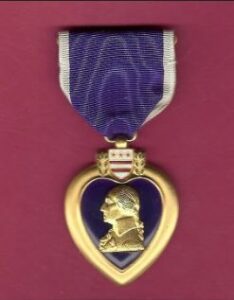 main Japanese island, Kyushu, with the recently captured island of Okinawa to be used as a staging area. The second attack was planned for early 1946. Operation Coronet was supposed to be the invasion of the Kanto Plain, near Tokyo, on the main Japanese island of Honshu. Important airbases on Kyushu that would be captured in Operation Olympic would allow land-based air support for Operation Coronet. If Downfall had taken place, it would have been the largest amphibious operation in history…even surpassing D-Day.
main Japanese island, Kyushu, with the recently captured island of Okinawa to be used as a staging area. The second attack was planned for early 1946. Operation Coronet was supposed to be the invasion of the Kanto Plain, near Tokyo, on the main Japanese island of Honshu. Important airbases on Kyushu that would be captured in Operation Olympic would allow land-based air support for Operation Coronet. If Downfall had taken place, it would have been the largest amphibious operation in history…even surpassing D-Day.
This planned set of attacks was no mystery to Japan either, because their geography made this invasion plan quite obvious. The Japanese were able to accurately predict the Allied invasion plans, and they adjusted their defensive plan, known as Operation  Ketsugo, accordingly. The Japanese planned an all-out defense of Kyushu, with little left in reserve for any subsequent defense operations. Casualty predictions varied widely, but they were expected to be extremely high. Depending on the degree to which Japanese civilians would have resisted the invasion, estimates ran up into the millions for Allied casualties. No wonder the United States expected to need 1 million Purple Heart medals. Thankfully, those millions of Allied casualties never materialized, because when the atomic bombs were dropped on Hiroshima and Nagasaki, the war ended. The United States was left with 1 million Purple Heart medals, which they are still using today. I think that while having 1 million Purple Heart medals isn’t the worst thing ever, just the fact that we still have some of those 1 million Purple Heart medals means that, in some way, we have kept some of our soldiers safe over the years. I don’t know how many are left, but it doesn’t matter, because at this point, 78 years later…there are some left.
Ketsugo, accordingly. The Japanese planned an all-out defense of Kyushu, with little left in reserve for any subsequent defense operations. Casualty predictions varied widely, but they were expected to be extremely high. Depending on the degree to which Japanese civilians would have resisted the invasion, estimates ran up into the millions for Allied casualties. No wonder the United States expected to need 1 million Purple Heart medals. Thankfully, those millions of Allied casualties never materialized, because when the atomic bombs were dropped on Hiroshima and Nagasaki, the war ended. The United States was left with 1 million Purple Heart medals, which they are still using today. I think that while having 1 million Purple Heart medals isn’t the worst thing ever, just the fact that we still have some of those 1 million Purple Heart medals means that, in some way, we have kept some of our soldiers safe over the years. I don’t know how many are left, but it doesn’t matter, because at this point, 78 years later…there are some left.
 What would make a tiny nation try to invade a nation that is more that 25 times larger, with a population that is at least 8 times larger? It makes no sense, and yet on February 15, 1937, Japan attempted to invade China. Japan, with a total of 60,000 soldiers enter Northern China using planes and tanks. The invasion was something they had studied so they would have a plan before they attempted such an outlandish scheme. The type of conquest they were trying to mimic was that of Kubia Kahn, the Mongol emperor, who in 1271, established the Yuan dynasty and formally claimed orthodox succession from prior Chinese dynasties. The Yuan dynasty came to rule over most of present-day China, Mongolia, Korea, southern Siberia, and other adjacent areas. Kahn also amassed influence in the Middle East and Europe as khagan. By 1279, the Yuan conquest of the Song dynasty was completed, and Kahn became the first non-Han emperor to rule all of China proper.
What would make a tiny nation try to invade a nation that is more that 25 times larger, with a population that is at least 8 times larger? It makes no sense, and yet on February 15, 1937, Japan attempted to invade China. Japan, with a total of 60,000 soldiers enter Northern China using planes and tanks. The invasion was something they had studied so they would have a plan before they attempted such an outlandish scheme. The type of conquest they were trying to mimic was that of Kubia Kahn, the Mongol emperor, who in 1271, established the Yuan dynasty and formally claimed orthodox succession from prior Chinese dynasties. The Yuan dynasty came to rule over most of present-day China, Mongolia, Korea, southern Siberia, and other adjacent areas. Kahn also amassed influence in the Middle East and Europe as khagan. By 1279, the Yuan conquest of the Song dynasty was completed, and Kahn became the first non-Han emperor to rule all of China proper.
So, with dreams of power and world domination, among other things, including a need for the resources Japan lacked and China had, the Japanese army under Emperor Hirohito made the decision to attack the much larger  and more populated China. They threatened to bottle up 400,000 Chinese people on China’s central front. The attack area was approximately 20 miles, from the Yellow River to the Henan Capital provincial (Kaifeng). The Japanese Army displayed far superior air power and many more combat troops during the Japanese onslaught. In fact, their might could easily be called terrifying. China was helpless at stopping the Japanese forces from occupying Shanghai, and they were barely able prevent the invasion of Japan on the capital. The Chinese desperately tried to fight back with small caliber weapons against the heavy artillery fire power, air and naval might, and armored defenses of Japan. While they were severely outgunned, the bravery, stubbornness and determination of the Chinese made it possible for the country to withstand three months of defending Shanghai. Nevertheless, in the end, Shanghai fell, and Japan gained control over the city. The best of China’s troops were defeated. Still, the Japanese were surprised at the length of time that the Chinese troops were able to make a stand for their capital city. Because of their military superiority, the Japanese fully expected a short battle and a swift victory. They were not prepared for the one variable…the determination of the Chinese
and more populated China. They threatened to bottle up 400,000 Chinese people on China’s central front. The attack area was approximately 20 miles, from the Yellow River to the Henan Capital provincial (Kaifeng). The Japanese Army displayed far superior air power and many more combat troops during the Japanese onslaught. In fact, their might could easily be called terrifying. China was helpless at stopping the Japanese forces from occupying Shanghai, and they were barely able prevent the invasion of Japan on the capital. The Chinese desperately tried to fight back with small caliber weapons against the heavy artillery fire power, air and naval might, and armored defenses of Japan. While they were severely outgunned, the bravery, stubbornness and determination of the Chinese made it possible for the country to withstand three months of defending Shanghai. Nevertheless, in the end, Shanghai fell, and Japan gained control over the city. The best of China’s troops were defeated. Still, the Japanese were surprised at the length of time that the Chinese troops were able to make a stand for their capital city. Because of their military superiority, the Japanese fully expected a short battle and a swift victory. They were not prepared for the one variable…the determination of the Chinese  people. Morale plummeted over the heavy losses incurred, but not for long.
people. Morale plummeted over the heavy losses incurred, but not for long.
I sometimes wonder if these heads of governments really think that they can somehow control the world, or even, if they really think they can control the country they have invaded. The main reasons that nations and borders change as often as they do, is that people will only live under oppression for so long. Then, they will fight back. As to the heads of nations and ruling the world. While they might be the “head” of their nation, in a situation of world domination, I seriously doubt if any of these national leaders would be the one in control.

 Like most holidays, Valentine’s Day has different meanings for different groups of people. At one time, back in the 400s, it was to celebrate the coming of Spring. It was also a day to celebrate two saints named Valentine. It was a way of honoring them. These days, I think it is pretty much universally known as a holiday to celebrate love, and even friendship.
Like most holidays, Valentine’s Day has different meanings for different groups of people. At one time, back in the 400s, it was to celebrate the coming of Spring. It was also a day to celebrate two saints named Valentine. It was a way of honoring them. These days, I think it is pretty much universally known as a holiday to celebrate love, and even friendship.
Of course, the flower, candy, and greeting card industries, as well as the restaurant industry, have really profited from the Valentine’s Day tradition of showing our love, and I think that’s ok. While some people consider the day to be a forced display, I feel like it is a great way to show people how much they mean to you. I don’t really understand why people consider it a burden. In our family we always brought candy to our parents and siblings, and I love to continue that with my kids, grandkids, and great grandkids. To see the smiles on their faces, is all I need to feel happy.
With restaurants so busy on Valentine’s Day, my husband, Bob and I always choose a different day to go out for dinner. Many other people feel the same way, and with that, Valentine’s Day has essentially become Valentine’s week. If a couple is going to become engaged on Valentine’s Day, or get married on Valentine’s Day, then no other day will do. That makes sense too. I don’t know how I would feel about getting engaged or married on a holiday, but many people think it’s a great idea to mix the holiday with their special day. Of course, becoming engaged on those holidays is w very different thing. Still, to each his own, as they say. However, you choose to celebrate, or not celebrate Valentine’s Day, it will always be remembered as a day to 
 celebrate love.
celebrate love.
Whatever you decide to do, I hope you have a wonderful day, and if you decide to celebrate the coming of Spring, well…it’s truly just around the corner. And about that, I am completely happy. To my family, friends, and my love…Bob, I say Happy Valentine’s Day. May your day, or week be wonderful!!

 These days, it seems that every day is a designated “something” day, and some days might have multiple designations. Of course, we all know the main holidays, but the lesser-known days are pretty cool too. February 14th is Valentine’s Day, but did you know that February 13th is Galentine’s Day…which is a day for us to celebrate our girlfriends. Now I don’t mean romantic girlfriend, but rather like BFFs or Besties. You know a girl has to have her best friends, and the 13th of February is the day to say, “Hey, you’re my BFF, and I want you to know how important you are to me. Other national days that happen to fall on February 13th are, National Cheddar Day, Kiss Day, National Football Hangover Day, and National Tortellini Day…just to name a few.
These days, it seems that every day is a designated “something” day, and some days might have multiple designations. Of course, we all know the main holidays, but the lesser-known days are pretty cool too. February 14th is Valentine’s Day, but did you know that February 13th is Galentine’s Day…which is a day for us to celebrate our girlfriends. Now I don’t mean romantic girlfriend, but rather like BFFs or Besties. You know a girl has to have her best friends, and the 13th of February is the day to say, “Hey, you’re my BFF, and I want you to know how important you are to me. Other national days that happen to fall on February 13th are, National Cheddar Day, Kiss Day, National Football Hangover Day, and National Tortellini Day…just to name a few.
There are also National Weeks and Months as we all know. This week happen to be Nation Random Acts of Kindness Week, and I think that is a wonderful idea. After all, this world could use a little (or maybe a lot) more kindness. Random Acts of Kindness Week encourages people out there and show just how easy it is to give to others. This holiday is all about making kindness a standard for others to follow to make the world around us a nicer place to live.
One way to celebrate National Kindness Week is to show appreciation for those around us, seeing others with a need, and teaching our kids to practice kindness. It is celebrated on the second week of February, and it inspires people all over the world to make the lives of other people just a little bit better. Of course, people should be kind to each other all the time, and while many national days and weeks are for silly things, but this one is something that we should try to celebrate all year long, if you ask me. I think it’s even more fun to practice random acts of kindness anonymously.
The holiday week officially started through the Random Acts of Kindness (RAK) organization. It was designed to let people give back to others through random acts, whether that be taking a trip to Africa to feed the poor, show support for cancer patients, or helping someone on the road fix their flat tires. RAK, a non-profit organization, is located in Denver, Colorado, and consists of a small team that works hard to inspire others. The 
 RAK program offers resources for those wishing to participate during the week, including school programs, calendars, videos, and training materials. While that is great, people don’t have to be involved in a formal program to participate. All you need is a compassionate heart, a willingness to give, and a watchful eye, so you know when and who needs your own special brand of a random act of kindness.
RAK program offers resources for those wishing to participate during the week, including school programs, calendars, videos, and training materials. While that is great, people don’t have to be involved in a formal program to participate. All you need is a compassionate heart, a willingness to give, and a watchful eye, so you know when and who needs your own special brand of a random act of kindness.

 I don’t know about you, but when I hear “art museum,” I think of a stuffy old building with walls and walls of paintings on them…usually old paintings that, while probably priceless, are not something I would probably be interested in. I’m sure that is what many art museums look like, but not all of them do. Some art museums are actually very beautiful, like the Louvre, which is both beautiful and unique. Still other museums could only be classified as “different” and even strange!!
I don’t know about you, but when I hear “art museum,” I think of a stuffy old building with walls and walls of paintings on them…usually old paintings that, while probably priceless, are not something I would probably be interested in. I’m sure that is what many art museums look like, but not all of them do. Some art museums are actually very beautiful, like the Louvre, which is both beautiful and unique. Still other museums could only be classified as “different” and even strange!!
The Graz Art Museum is a futuristic-looking building in the heart of Graz, Austria, and this building will definitely catch your eye. The Graz Art Museum is not an old building, but it could be classified as historic…simply because of how it looks. The building is in the heart of Graz, but in reality, it is the Heart of Graz. It may not be called that, but it should be. This relatively “young” building was built in 2003 for the purpose of European Capital of Culture program. The really cool thing about this building is that it was built in the shape of a robotic heart, which makes it stand out from the typical Austrian architecture. The surface of the museum has almost 1000 fluorescent rings which create different patterns at night, and another cool thing is that most of the power energy of the museum comes from solar panels on the roof, making it much more inexpensive to operate.
Whether you’re an art fan or not, you must admit that this museum is, to say the least, interesting. The museum is really a work of art in itself. The round led lights that cover the exterior of the electronic heart shaped building…complete with the arteries…are lit at night to add a futuristic air to the building, displaying 
 different shapes and such on different nights. The interior is as futuristic as the exterior. Even the art that is on display is futuristic. The whole place has an almost “outer space” feel to it. I suppose it could be quite different on the inside, and if I were there in person, it might seem entirely like a normal museum, but I rather think not. I think it might be very difficult for this museum to be “normal” in any way.
different shapes and such on different nights. The interior is as futuristic as the exterior. Even the art that is on display is futuristic. The whole place has an almost “outer space” feel to it. I suppose it could be quite different on the inside, and if I were there in person, it might seem entirely like a normal museum, but I rather think not. I think it might be very difficult for this museum to be “normal” in any way.
 Evil can be just around the corner, and sadly, sometimes, the evil doers walk away without being punished for their crimes. On the morning of February 10, 1990, the staff at Las Cruces Bowl were busy getting ready for the Saturday bowling crowd, when two armed men walked in through an unlocked door. The men were there to rob the place. They could have worn masks, or they could have just robbed the place and fled the scene, but they had no intention of being caught, and that meant that they couldn’t leave witnesses.
Evil can be just around the corner, and sadly, sometimes, the evil doers walk away without being punished for their crimes. On the morning of February 10, 1990, the staff at Las Cruces Bowl were busy getting ready for the Saturday bowling crowd, when two armed men walked in through an unlocked door. The men were there to rob the place. They could have worn masks, or they could have just robbed the place and fled the scene, but they had no intention of being caught, and that meant that they couldn’t leave witnesses.
Stephanie C Senac, 34, who was the bowling alley manager, was in her office preparing to open the for the day. Her 12-year-old daughter Melissa Repass and Melissa’s 13-year-old friend Amy Houser were there to supervise the alley’s day care. The gunmen took them into the office, where they robbed them of a mere $4,000 to $5,000. As robberies go, it was practically nothing. When bowling alley mechanic Steven Teran came in with his two young daughters, Paula Holguin and Valerie Teran, they were totally unprepared for what faced them. Teran was unable to find a  babysitter for his daughters that day, so he had decided that he would drop them at the bowling alley daycare for the Melissa and Amy to watch. As the robbers took cash from the safe, the seven unfortunate people, including Teran and his daughters; cook Ida Holguin (no relation to Paula); manager Stephanie Senac, her daughter, and her daughter’s friend tried to be cooperative in the hope of making it out alive, but the men told them to get down on the ground. Then they shot all of the victims multiple times at close range, aiming mostly for their heads. When the shooting was over, they were still not satisfied with how things stood, so they set fire to some papers in the office of the bowling alley and left.
babysitter for his daughters that day, so he had decided that he would drop them at the bowling alley daycare for the Melissa and Amy to watch. As the robbers took cash from the safe, the seven unfortunate people, including Teran and his daughters; cook Ida Holguin (no relation to Paula); manager Stephanie Senac, her daughter, and her daughter’s friend tried to be cooperative in the hope of making it out alive, but the men told them to get down on the ground. Then they shot all of the victims multiple times at close range, aiming mostly for their heads. When the shooting was over, they were still not satisfied with how things stood, so they set fire to some papers in the office of the bowling alley and left.
Miraculously, Ida, Senac, and Melissa all survived. Melissa, despite being shot five times, was able to call 911. Unfortunately, the fire and subsequent efforts to put out the fire destroyed most of the evidence. In those days, forensics mostly involved fingerprints, which were in abundance in the bowling alley. DNA was not really as  developed at that time. Investigators were unable to discern which fingerprints were meaningful. There were witnesses, of course, who identified the suspects as two Hispanic men, in their 30s or 40s. Roadblocks were quickly set up by the police, to screen anyone leaving town. Still, the suspects were never found. Despite a frequent stream of tips, authorities are no closer to identifying and arresting the suspects today than they were 32 years ago…even with age enhanced pictures. The murders have been shown on multiple crime solving programs, including on Unsolved Mysteries two and a half months after the murders, and on America’s Most Wanted twice, once in November 2004 and again in March 2010. In the end, the crime also took the life of Stephanie Senac, who died in 1999…nine years later, due to complications from her injuries. The men got away with just $4,000 to $5,000, but the victims paid dearly.
developed at that time. Investigators were unable to discern which fingerprints were meaningful. There were witnesses, of course, who identified the suspects as two Hispanic men, in their 30s or 40s. Roadblocks were quickly set up by the police, to screen anyone leaving town. Still, the suspects were never found. Despite a frequent stream of tips, authorities are no closer to identifying and arresting the suspects today than they were 32 years ago…even with age enhanced pictures. The murders have been shown on multiple crime solving programs, including on Unsolved Mysteries two and a half months after the murders, and on America’s Most Wanted twice, once in November 2004 and again in March 2010. In the end, the crime also took the life of Stephanie Senac, who died in 1999…nine years later, due to complications from her injuries. The men got away with just $4,000 to $5,000, but the victims paid dearly.

 My sister, Allyn Hadlock has had quite an unusual year. Allyn has worked at Wyoming Medical Center (now Banner Health) for twenty years now. She is the Senior Manager of the PFS Billing Unit. She is well liked and works hard, but with so many changes in the working world since Covid happened, Allyn has really had working from home on her heart. At first, it seemed like an impossibility, but when Banner purchased WMC, the idea surfaced again…both in my sister’s mind, and thankfully in the minds of the new owners. So, on Monday, December 12, 2022, Allyn went home to work!!! It was a dream come true.
My sister, Allyn Hadlock has had quite an unusual year. Allyn has worked at Wyoming Medical Center (now Banner Health) for twenty years now. She is the Senior Manager of the PFS Billing Unit. She is well liked and works hard, but with so many changes in the working world since Covid happened, Allyn has really had working from home on her heart. At first, it seemed like an impossibility, but when Banner purchased WMC, the idea surfaced again…both in my sister’s mind, and thankfully in the minds of the new owners. So, on Monday, December 12, 2022, Allyn went home to work!!! It was a dream come true.
Allyn and her husband Chris Hadlock had inherited his parents’ property on the Platte River after his mom passed away a few years ago, and they removed the old house that was there and in pretty bad shape. Then, they had a brand-new home built there. The home was finished a few years ago, except for the unfinished attic. They had a bed up there for when their kids came to stay, but the rest of the 
 attic was open. Now, it is all finished, complete with a really nice guest suite, a sitting area, and two offices. Chris doesn’t work from home most of the time, but sometimes he does. Allyn, however, simply wakes up, has her breakfast and gets ready for her day. Then she and her dog, Liberty go upstairs for the day. She painted her office in her favorite color…yellow, and she has all her favorite things in there. Nevertheless, when she is in the office during working hours, she is all business.
attic was open. Now, it is all finished, complete with a really nice guest suite, a sitting area, and two offices. Chris doesn’t work from home most of the time, but sometimes he does. Allyn, however, simply wakes up, has her breakfast and gets ready for her day. Then she and her dog, Liberty go upstairs for the day. She painted her office in her favorite color…yellow, and she has all her favorite things in there. Nevertheless, when she is in the office during working hours, she is all business.
This year found Allyn making two trips to Arizona. In November, she went to Phoenix on a work trip. Of course, we were all jealous, because it was really cold here in Wyoming, and she got to take almost a week and go be in the warmth. It was a working trip, but she learned a lot, and the trip was very successful. Then, at the end of December, Allyn and Chris got to join daughter, Lindsay Moore; Lindsay’s husband, Shannon; and daughter, Mackenzie; as 
 well as Shannon’s parents, Mary Jo and Tom Moore, in Tucson, Arizona for the Arizona Bowl game. Shannon is one of the coaches of the Cowboys. The team had won a spot in the game. Unfortunately, after a hard-fought game, the Cowboys lost, but the Hadlock/Moore families had an amazing time, and for the second time this winter, Allyn got to escape the cold in sunny Arizona. Today is Allyn’s 60th birthday. Happy birthday Allyn!! Have a great day!! We love you!!
well as Shannon’s parents, Mary Jo and Tom Moore, in Tucson, Arizona for the Arizona Bowl game. Shannon is one of the coaches of the Cowboys. The team had won a spot in the game. Unfortunately, after a hard-fought game, the Cowboys lost, but the Hadlock/Moore families had an amazing time, and for the second time this winter, Allyn got to escape the cold in sunny Arizona. Today is Allyn’s 60th birthday. Happy birthday Allyn!! Have a great day!! We love you!!

 My grandnephew, Jake Harman is quite likely one of the happiest people I know. He spreads happiness to everyone around him. Jake works for the City of Casper, as a bus driver for the Link public transportation system, and all his riders absolutely love him, and he loves them too. He’s got nicknames for a lot of them as well, because that is what Jake does. He loves people and often “adopts” them as a part of his “family.” No, he doesn’t take them home with him, but Jake really has never met a stranger. He is a people person and makes friends very easily. His upbeat personality puts a smile on everyone’s face. I know this to be a fact, because whenever I am around him, I can’t help but smile. He always makes me feel like I am his favorite person. I think that is how he makes everyone feel, even though, I like to think I’m his favorite great aunt. Doesn’t every aunt want that?
My grandnephew, Jake Harman is quite likely one of the happiest people I know. He spreads happiness to everyone around him. Jake works for the City of Casper, as a bus driver for the Link public transportation system, and all his riders absolutely love him, and he loves them too. He’s got nicknames for a lot of them as well, because that is what Jake does. He loves people and often “adopts” them as a part of his “family.” No, he doesn’t take them home with him, but Jake really has never met a stranger. He is a people person and makes friends very easily. His upbeat personality puts a smile on everyone’s face. I know this to be a fact, because whenever I am around him, I can’t help but smile. He always makes me feel like I am his favorite person. I think that is how he makes everyone feel, even though, I like to think I’m his favorite great aunt. Doesn’t every aunt want that?
Jake is one of those guys who will always be young at heart…or as his wife, Melanie says a “big child” at heart. In reality, he probably is a big kid. Like many men, I don’t think he will ever really grow up, and maybe that isn’t a bad thing. Growing up…or growing old, isn’t all it’s cracked up to be, and I think those guys who stay a big kid have the most fun in life. Jake is dad to Alice (his bonus daughter), Izabella, and Jaxx. They have benefitted greatly from Jake’s “young at heart” ways, because he still gets down on the floor and plays with the kids all the time. They love to tackle him…when they can get the better of him. It’s just as fun when he wins 
 too, because the whole goal is to have a big wrestling match with their daddy…and Jake never minds the noise.
too, because the whole goal is to have a big wrestling match with their daddy…and Jake never minds the noise.
Melanie tells he that he is “an amazing dad and husband. Don’t know what we would ever do without him in our lives! God put him and me together and I am so grateful for it every day! We have our scuffles, but we are perfect for each other.” Every marriage has its “scuffles.” It’s the rest of the marriage that really matters. She tells me that “his smile is for sure my weakness, lol!” I think anyone who knows Jake can say pretty much the same thing. Jake’s smile is his greatest asset, without a doubt. It shows how joyful he is. His smile always leaves you smiling too. Today is Jake’s birthday. Happy birthday Jake!! Have a great day!! We love you!!
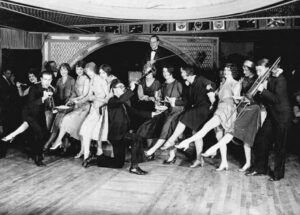 The Great Depression…while the main problem at that time in history was a lack of jobs and money, another huge problem was depression…real emotional depression. Of course, people just had to deal with that. There was nothing anyone could do about it…or was there? There was little that could be done about money, but maybe there was a way to lift everyone’s spirits and do some good too. So began the Depression Era Dance Marathons.
The Great Depression…while the main problem at that time in history was a lack of jobs and money, another huge problem was depression…real emotional depression. Of course, people just had to deal with that. There was nothing anyone could do about it…or was there? There was little that could be done about money, but maybe there was a way to lift everyone’s spirits and do some good too. So began the Depression Era Dance Marathons.
Dance Marathons (also called Walkathons) were an American phenomenon of the 1920s and 1930s. While they began as human endurance contests in which couples danced almost non-stop for hundreds of hours (as long as a month or two), competing for prize money, that couldn’t continue during the Great Depression years. Still, the dance marathons did continue throughout the 1930s as partially staged 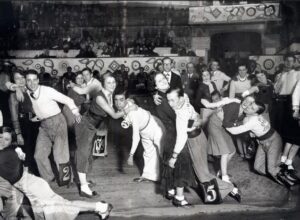 performance events that mirrored the marathons of the Roaring Twenties. In the dance endurance contests of the 20s, a mix of local hopefuls and seasoned professional marathoners danced, walked, shuffled, sprinted, and sometimes cracked under the pressure and exhaustion of round-the-clock motion. The Depression Era Dance Marathons weren’t exactly a means of keeping the American spirit up through the darkest financial crisis in its history, but rather they were human endurance contests that served as a way of giving broke married couples a roof over their head and food to eat for a few days.
performance events that mirrored the marathons of the Roaring Twenties. In the dance endurance contests of the 20s, a mix of local hopefuls and seasoned professional marathoners danced, walked, shuffled, sprinted, and sometimes cracked under the pressure and exhaustion of round-the-clock motion. The Depression Era Dance Marathons weren’t exactly a means of keeping the American spirit up through the darkest financial crisis in its history, but rather they were human endurance contests that served as a way of giving broke married couples a roof over their head and food to eat for a few days.
The real emphasis here is on the word contest. People had needs, and so they were highly motivated to win the contest. It was a good thing that these dancers were young people, because marathon dancing takes a lot of stamina. The couples would actually take 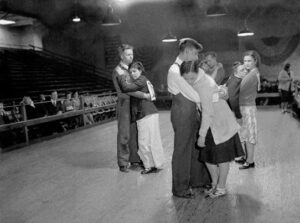 turns sleeping while their partner propped up and continued dancing with them. That kind of endurance was no easy feat, but in the end, it was all worth it…for the winners anyway. When you think about it, it while the marathons were a good idea, and the prizes really helped people out, it had to be exhausting, and it was definitely not for the older generation. You had to be young in body, in addition to being young at heart to endure all that. These couples danced their hearts out. Nevertheless, at some point, the couples finally gave out, until there was only one couple left, and the winners were announced. It was a contest of endurance. While they really needed the prize, I’m sure these couples had a great time too.
turns sleeping while their partner propped up and continued dancing with them. That kind of endurance was no easy feat, but in the end, it was all worth it…for the winners anyway. When you think about it, it while the marathons were a good idea, and the prizes really helped people out, it had to be exhausting, and it was definitely not for the older generation. You had to be young in body, in addition to being young at heart to endure all that. These couples danced their hearts out. Nevertheless, at some point, the couples finally gave out, until there was only one couple left, and the winners were announced. It was a contest of endurance. While they really needed the prize, I’m sure these couples had a great time too.
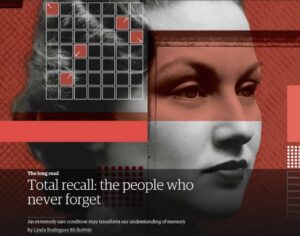
 Imagine being able to remember every day of your life, or maybe, not being able to forget any of it. Everyone is different, and the brain is quite mysterious. Some people have vague or no specific memories about their past, while others remember all the details of their lives. Some people can even give specific days, times, and weather conditions that were present at the time of a memory. Now, some people might call that a blessing, while others might see it as a curse. Either way, it is a bit of a novelty, to say the least. The condition is called Highly Superior Autobiographical Memory (HSAM), and as of 2017, fewer than 100 people were known to have the condition. The main characteristic of the condition is that the patient has a near-perfect memory for recalling dates and events. The scientific term for Superior Autobiographical Memory is Hyperthymesia. This form of memory is sometimes confused with Eidetic Memory, which is itself mistakenly associated with photographic memory. Superior Autobiographical Memory or Hyperthymesia is a confusing phenomenon, even for scientists.
Imagine being able to remember every day of your life, or maybe, not being able to forget any of it. Everyone is different, and the brain is quite mysterious. Some people have vague or no specific memories about their past, while others remember all the details of their lives. Some people can even give specific days, times, and weather conditions that were present at the time of a memory. Now, some people might call that a blessing, while others might see it as a curse. Either way, it is a bit of a novelty, to say the least. The condition is called Highly Superior Autobiographical Memory (HSAM), and as of 2017, fewer than 100 people were known to have the condition. The main characteristic of the condition is that the patient has a near-perfect memory for recalling dates and events. The scientific term for Superior Autobiographical Memory is Hyperthymesia. This form of memory is sometimes confused with Eidetic Memory, which is itself mistakenly associated with photographic memory. Superior Autobiographical Memory or Hyperthymesia is a confusing phenomenon, even for scientists.
The first person diagnosed with HSAM was Jill Price, who in 2000 emailed Dr James McGaugh, a professor in neurobiology and behavior at UC Irvine, about her memory problem. Strange that she called it a “memory problem” and not just an unusually good memory. Price wrote, “Whenever I see a date flash on the television…I automatically go back to that day and remember where I was, what I was doing, what day it fell on…” She described the experience as “nonstop, uncontrollable, and totally exhausting.” I think that part…especially the “totally exhausting” part, is something that most people wouldn’t even consider when it comes to memory, but then we have never been faced with a situation quite like that of Jill Price.
After receiving Price’s email, Dr McGaugh started researching the condition. Like most of us, it was something he had never given much thought to. His research took a long time, because information and case studies were pretty much non-existent, but in 2010, he appeared on 60 Minutes to discuss his findings. The 60 Minutes segment caused other people to reach out to him about their own version of the condition. Among the people who reached out to him was Joey DeGrandis, who had been aware of his near-perfect memory since he was 10. DeGrandis actually took a different approach to his situation than Price had. In fact, he treated his memory somewhat like a magic trick…even performing at a school magic show by accurately naming what day of the week any date in recent history fell on. He had previously considered his memory a novelty, he changed his opinion on it after hearing about other people with the condition and decided to take part in McGaugh’s studies.
The research into HSAM showed addition things that most of us wouldn’t thing about. One thing that the research showed was that many people with HSAM also suffer with obsessive traits. DeGrandis told Time he felt his HSAM contributed to his occasional bouts of depression and anxiety, as he struggles to let go of certain things. While many people think that HSAM is the same as having a photographic memory, that is actually not the case. Oddly, people with HSAM have no advanced memory when it comes to remembering things like names or faces. DeGrandis said in a 2017 interview with Time magazine, “I’m not great with names, or with mundane details like whether I brushed my teeth today or where I put my keys.”
I guess that we will never fully understand the human mind and memory, because while I can’t even begin to claim any link between HSAM and me, I find that I do quite well with names and faces, as well as remembering 
 computer procedures (once I’m shown one time), and a pretty good aptitude for medical procedure (at least as it applies to caregiving). I consider these things, at least a little bit like a photographic memory, since I can actually picture the computer screens in my head when I’m explaining steps to take with phones or computers to my family. The mind is an amazing thing, and I doubt if we will ever fully understand all it is capable of.
computer procedures (once I’m shown one time), and a pretty good aptitude for medical procedure (at least as it applies to caregiving). I consider these things, at least a little bit like a photographic memory, since I can actually picture the computer screens in my head when I’m explaining steps to take with phones or computers to my family. The mind is an amazing thing, and I doubt if we will ever fully understand all it is capable of.

